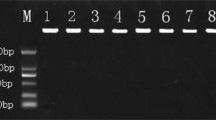Abstract
The phylogenetic relationships of the genus Sorghum and related genera were studied by sequencing the nuclear ribosomal DNA (rDNA) internal transcribed spacer region (ITS). DNA was extracted from 15 Sorghum accessions, including one accession from each of the sections Chaetosorghum and Heterosorghum, four accessions from Parasorghum, two accessions from Stiposorghum, and seven representatives from three species of the section Sorghum (one accession from each of S. propinquum and S. halepense, and five races of S. bicolor). The maize (Zea mays) line, H95, and an accession from Cleistachne sorghoides were also included in the study. Variable nucleotides were used to construct a strict consensus phylogenetic tree. The analyses indicate that S. propinquum, S. halepense and S. bicolor subsp. arundinaceum race aethiopicum may be the closest wild relatives of cultivated sorghum; Sorghum nitidum may be the closest 2n=10 relative to S. bicolor, the sections Chaetosorghum and Heterosorghum appear closely related to each other and more closely related to the section Sorghum than Parasorghum; and the section Parasorghum is not monophyletic. The results also indicate that the genus Sorghum is a very ancient and diverse group.
Similar content being viewed by others
References
Appels R, Dvorak J (1982) The wheat ribosomal DNA spacer region: its structure and variation in populations and among species. Theor Appl Genet 63:337–348
Baldwin BG (1992) Phylogenetic utility of the internal transcribed spacers of nuclear ribosomal DNA in plants: an example from the Compositae. Mol Phylog Evol 1:3–16
Bhatti AG, Endrizzi JE, Reeves RG (1960) Origin of Johnson grass. J Hered 51:106–110
Celarier RP (1957) Cytotaxonomic notes on the subsection halepensia of the genus Sorghum. Bull Torrey Bot Club 85:49–62
Celarier RP (1958) Cytotaxonomy of the Andropogoneae. III. Subtribe Sorgeae, Genus Sorghum. Cytologia 23:395–418
Chittenden LM, Shertz KF, Lin YR, Wing RA, Paterson AH (1994) A detailed RFLP map of Sorghum bicolor S. propinquum suitable for high-density mapping suggests ancestral duplication of Sorghum chromosomes or chromosomal segments. Theor Appl Genet 87:925–933
De Wet JMJ (1978) Systematics and evolution of Sorghum sect. Sorghum (Gramineae). Am J Bot 65:477–484
De Wet JMJ, Harlan JR (1971) The origin and domestication of Sorghum bicolor Econ Bot 25:128–135
De Wet JMJ, Huckabay JP (1967) The origin of Sorghum bicolor II. Distribution and domestication. Evolution 21:787–802
Doggett H (1976) Sorghum Sorghum bicolor (Gramineae-Andropogoneae). In: Simmonds NW (ed) Evolution of crop plants. Longman Group Limited, London
Duvall MR, Doebley JF (1990) Restriction-site variation in the chloroplast genome of Sorghum (Poaceae). Systematic Bot 15:472–480
Garber ED (1950) Cytotaxonomic studies in the genus Sorghum. Univ Calif Publ Bot 23:283–361
Gu MH, Ma HT, Liang GH (1984) Karyotype analysis of seven species in the genus Sorghum. J Hered 75:196–202
Hamby RK, Zimmer EA (1992) Ribosomal RNA as a phylogenetic tool in plant systematics. In: Soltis PS, Soltis DE, Doyle JJ (eds) Molecular systematics of plants. Routledge, Chapman and hall, Inc., New York London, pp 50–91
Helentjaris T, Weber D, Wright S (1988) Identification of genomic locations of duplicate nucleotide sequences in maize by analysis of restriction fragment length polymorphism. Genetics 118:353–363
Hulbert SH, Bennetzen JL (1991) Recombination at the RP1 locus of maize. Mol Gen Genet 226:377–382
Hulbert SH, Richter TD, Axtell JD, Bennetzen JL (1990) Genetic mapping and characterization of sorghum and related crops using maize RFLP probes. Proc Natl Acad Sci USA 87:4251–4255
Liang GH, Casady AJ (1966) Quantitative presentation of the systematic relationships among twenty-one Sorghum species. Crop Sci 6:76–79
Mann JA, Kimber CT, Miller FR (1983) The origin and early cultivation of sorghum in Africa. Texas Agri Exp St Bull No. 1454
Melake Berhan A, Hulbert SH, Butler LG, Bennetzen JF (1993) Structure and evolution of the genomes of Sorghum bicolor and Zea mays. Theor Appl Genet 86:598–604
Saghai-Maroof MA, Soliman KM, Jorgensen RA, Allard RW (1984) Ribosomal DNA spacer-length polymorphisms in barley: Mendelian inheritance, chromosomal location, and population dynamics. Proc Natl Acad Sci USA 81:8014–8018
Sambrook J, Fritsh EF, Maniatis T (1989) Molecular cloning: a laboratory manual. Cold Spring Harbor Laboratory, Cold Spring Harbor, New York
Snowden JD (1935) A classification of the cultivated sorghum. Bull Misc Info, No.5. Royal Botanic Garden, Kew, England
Springer PS, Zimmer EA, Bennetzen JL (1989) Genomic organization of the ribosomal DNA of sorghum and its close relatives. Theor Appl Genet 77:844–850
Swofford DL (1993) PAUP: Phylogenetic analysis using parsimony. Computer program distributed by Illinois National History Survey. Champaign, Illinois
Takaiwa F, Oono K, Sugiura M (1985) Nucleotide sequence of the 17–25 region from rice rDNA. Plant Mol Biol 4:355–364
Tang H, Liang GH (1988) The genomic relationship between cultivated sorghum and Johnsongrass: a re-evaluation. Theor Appl Genet 76:277–284
Wei S (1984) Elementary survey of the cultivated origin of Kaoliang (Chinese sorghum)-Studies concerning unearthed samples in the historical site, Jingchun village, Wanrong County. Agri His Sinica 2:45–50
Whitkus R, Doebley J, Lee M (1992) Comparative genome mapping of sorghum and maize. Genetics 132:1119–1130
Wu TP (1984) Comparative karyomorphology of two species in Parasorghum. Proc Natl Sci Council Taiwan, China. Part B 6:319–325
Wu TP (1989) Cytotaxonomic studies in two polyploid species of the genus Sorghum. Proc Nat Sci Council Taiwan, China. Part B 13:15–22
Wu TP (1990) Sorghum macrospermum and its relationship to the cultivated species S. bicolor. Cytologia 55:141–151
Yokota YT, Lida KY, Kato A, Tanifuji S (1989) Nucleotide sequences of the 5.8 rRNA gene and internal transcribed spacer regions in carrot and broad bean ribosomal DNA. J Mol Evol 29:294–301
Zimmer EA, Jupe ER, Walbot V (1988) Ribosomal gene structure, Variation and inheritance in maize and its ancestors. Genetics 120:1125–1136
Author information
Authors and Affiliations
Additional information
Communicated by Y. Gleba
This research was partially supported by a Third Country Scholarship from Pioneer Hi-Bred International Incorporated Contribution 94-182-J from Kansas Agricultural Experiment Station
Rights and permissions
About this article
Cite this article
Sun, Y., Skinner, D.Z., Liang, G.H. et al. Phylogenetic analysis of Sorghum and related taxa using internal transcribed spacers of nuclear ribosomal DNA. Theoret. Appl. Genetics 89, 26–32 (1994). https://doi.org/10.1007/BF00226978
Received:
Accepted:
Issue Date:
DOI: https://doi.org/10.1007/BF00226978



